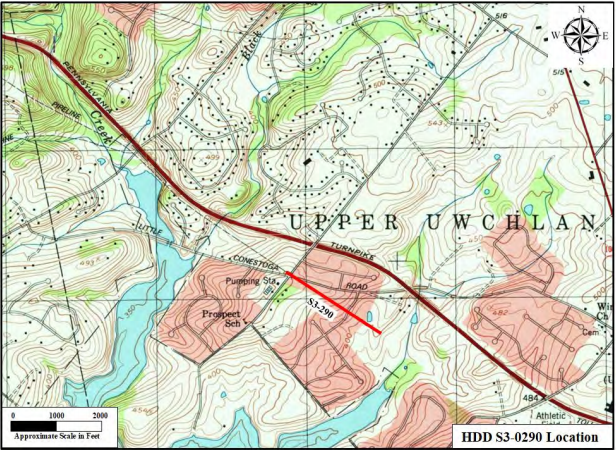
Sunoco is proposing to use horizontal directional drilling (HDD) to install its 20-inch Dragonpipe (Mariner East 2) pipeline between Little Conestoga Road and a point southeast of Highview Road in Upper Uwchlan Township, Chester County. The Department of Environmental Protection is asking for public comment on this plan, and I urge you to submit a comment. This blog post will help you decide what to say by describing some of the issues with this HDD plan. It will also tell you how to submit comments. You need to do this right away: the deadline is Tuesday, June 11.
In its plan, Sunoco has steadfastly refused to consider any alternatives to the approach it has chosen: HDD along the same right-of-way as the previously-installed 16-inch pipe. As I hope to show in this blog post, there are alternatives that Sunoco should have considered; and they should have presented their arguments for why their chosen plan was better. You can read Sunoco’s full plan here.
Problems with frac-outs. The 16-inch pipe in this area was installed using HDD in 2017. The drilling was begun in May of 2017, and the pipe was pulled through the following November. Sunoco reported two inadvertent returns (“frac-outs”), in which drilling mud surfaced at an unintended spot along the right-of-way. The new drilling plan calls for the pipe to follow essentially the same route, although it will be somewhat deeper (roughly 25 feet at the most). Frac-outs can probably be expected at the same locations, one next to a wetland, and the other in a small stream within the wetland.
In fact, the geophysical analysis required by the DEP as part of the plan shows many potential frac-out locations, so it is quite possible that more than the two reported by Sunoco in 2017 will occur. The geotechnical report concludes: “In general, the geophysical survey results display anomalies indicative of fractures that are possible locations for IRs [inadvertent returns] and/or loss of [drilling mud] along most of the HDD….”
Releasing drilling mud into a wetland is a violation of DEP regulations, and this plan suggests to me that Sunoco is content to use an approach that is likely to create such a violation. Otherwise, they would have given serious consideration to alternatives.
What about drinking water? The groundwater in this part of Chester County drains into Marsh Creek Lake, and the lake is the source of drinking water for a large section of the county. There is a good chance that Sunoco’s drilling mud (which includes a variety of materials in addition to clay) will migrate toward the lake from the points at which the bore crosses through ground water. That will happen at several points along the route. In fact, Sunoco “lost” 1,500 gallons of drilling mud at one point during the 2017 drilling. It probably went into the groundwater. Since groundwater can migrate very slowly, it may take months or years to know whether the lake water has been contaminated. This is another reason that Sunoco should have considered alternatives.
What about alternative routes? Sunoco reports that its project-wide analysis, prior to construction, had considered alternative routes and determined they were not “practicable”. (Sunoco was required to do an alternatives analysis for this specific plan for the 20-inch pipeline, but apparently did not. Instead, it simply referred back to its original permit application—which also did not provide any information about what alternatives might have been considered.) Sunoco says that it concluded this approach “has the least environmental impacts, taking into consideration cost, existing technology, and logistics”. That suggests to me that harm to water resources was very low on the list of considerations.
Sunoco correctly states that a route farther to the south would endanger Marsh Creek Lake. The company concedes that a route farther to the north (on the north side of the PA Turnpike) would be possible, but claims (on little evidence) that the current plan “is the preferred option”. The frac-outs on the planned route, they say, would be “readily contained and cleaned up with minimal effect to natural resources”.
Let the DEP know what you think! This plan has the potential to damage the drinking water from Marsh Creek Lake, as well as nearby wetlands and streams. Please submit your comments immediately. Feel free to make use of the information in this blog post in the comments you submit. But it is more effective if you use your own wording rather than simply copying mine. The DEP needs to hear from you!
Email your comments to: Ra-eppipelines@pa.gov
Mention the ID number for this section of the pipeline, which is S3-0290. The deadline is this Tuesday, June 11 (that’s tomorrow, if you’re reading this on Monday).
While you’re at it, why not copy your local state representative and senator? They need to hear your opinion too.

This plan for S3-0290 has the potential to damage the drinking water from Marsh Creek Lake, as well as nearby wetlands and streams.
LikeLike
Bad idea to build a pipe line near our drinking water. Don’t do it. Find another route.
LikeLike
Renewable sources! Follow the example of other 1st world countries that are smart enough to realize there is no planetB. We’ve fallen so far behind under the current “Administration. “
LikeLike
No, No, No! Please forget it and think let the US get more green energy! Our water sources should be sacred!
LikeLike
Please. NO!!!
LikeLike
Horrendous!
LikeLike
This is unsafe in so many ways! Complete disregard for the environment and safety and well being for humans and animals!
LikeLike
We absolutely have to stop bending the ways of nature to meet our short-term selfish wants. We have to work with the wonderful planet we have been blessed with. Sunoco folks need to take a close look at Mars,Venus,Mercury.
LikeLike